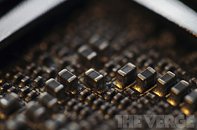- Joined
- Oct 9, 2007
- Messages
- 47,670 (7.43/day)
- Location
- Dublin, Ireland
| System Name | RBMK-1000 |
|---|---|
| Processor | AMD Ryzen 7 5700G |
| Motherboard | Gigabyte B550 AORUS Elite V2 |
| Cooling | DeepCool Gammax L240 V2 |
| Memory | 2x 16GB DDR4-3200 |
| Video Card(s) | Galax RTX 4070 Ti EX |
| Storage | Samsung 990 1TB |
| Display(s) | BenQ 1440p 60 Hz 27-inch |
| Case | Corsair Carbide 100R |
| Audio Device(s) | ASUS SupremeFX S1220A |
| Power Supply | Cooler Master MWE Gold 650W |
| Mouse | ASUS ROG Strix Impact |
| Keyboard | Gamdias Hermes E2 |
| Software | Windows 11 Pro |
Engineers at the University of Illinois have developed what they claim to be "self-repairing electronic circuits", which have the ability to restore broken circuits, and restore the functionality of whatever uses them. The technology works at the level of the PCB design, countless microscopic capsules filled with liquid metal are placed along with everything else, as the circuit board is being made. When the circuit is broken at a point, those micro-capsules break, and the secreted liquid metal gets channeled into the path of the broken portion of circuit, closing it back up (restoring it). This happens at a very small and localized scale, and dramatically increases MTBF (mean time before failure), if done right.
The researchers behind this technology call it an excellent solution for electronics that are supposed to be fail-safe, such as avionics, electronics running commercial aircraft, so broken circuits could fix themselves mid-air, and become operational within microseconds. Terms like "self healing electronics" and "liquid metal" instantly bring back pop-culture references to Hollywood epics such as the Terminator, and its dystopian future brought about when one of those self-healing circuits is also made "self-aware". And no, those are just surface-mounted capacitors in the picture.

View at TechPowerUp Main Site
The researchers behind this technology call it an excellent solution for electronics that are supposed to be fail-safe, such as avionics, electronics running commercial aircraft, so broken circuits could fix themselves mid-air, and become operational within microseconds. Terms like "self healing electronics" and "liquid metal" instantly bring back pop-culture references to Hollywood epics such as the Terminator, and its dystopian future brought about when one of those self-healing circuits is also made "self-aware". And no, those are just surface-mounted capacitors in the picture.

View at TechPowerUp Main Site






 Would be cool
Would be cool



